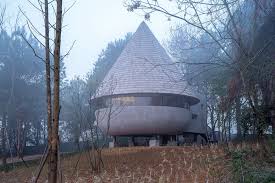
Mushroom houses, constructed from mycelium-based materials, are gaining attention for their potential to revolutionize architecture and sustainable building practices. These eco-friendly structures, which harness the natural properties of fungi, offer promising solutions to reduce carbon footprints in the construction industry. This article delves into the process of growing mushroom houses, the benefits of using mycelium, and the future of this innovative architectural approach.
What are Mushroom Houses?
Mushroom houses are structures built from materials derived from fungi, specifically mycelium. Mycelium is the root-like structure of fungi that grows underground and acts as a natural binding agent. It can be cultivated into bricks or insulation materials by feeding it with organic waste such as straw or wood chips, creating a strong, lightweight, and biodegradable material that can be used for construction.
The Process of Growing Mycelium for Construction
The first step in creating a mushroom house is cultivating the mycelium. Here’s an overview of the process:Substrate Preparation: The mycelium needs an organic substrate to grow on, such as agricultural waste (e.g., straw, sawdust, or corn husks). This substrate is sterilized to eliminate any contaminants.Inoculation: The substrate is then inoculated with the fungal spores, which will allow the mycelium to start growing and colonizing the material.Growth and Molding: Once inoculated, the mycelium begins to grow. It can be molded into specific shapes or forms (e.g., bricks, panels, or blocks) depending on the architectural design. Over a few days or weeks, the mycelium consumes the substrate and binds it together.
Drying and Hardening: After the mycelium has fully grown into its desired shape, the material is dried or heat-treated to stop further growth. This process also hardens the mycelium, making it durable enough for construction.
Benefits of Mushroom Houses
Using mycelium-based materials for construction offers several environmental and economic benefits:
Sustainability and Low Environmental Impact
Mycelium is a renewable and biodegradable material, which means that buildings made from it will have a significantly lower environmental impact compared to traditional materials like concrete or steel. Mycelium can be grown using waste materials, reducing the need for raw resources and promoting a circular economy.
Energy Efficiency
Mycelium has excellent insulating properties, making it ideal for energy-efficient buildings. Mushroom houses can help reduce heating and cooling costs by maintaining a stable indoor temperature, thus lowering energy
Carbon Sequestration
As mycelium grows, it captures and stores carbon, helping to reduce greenhouse gas emissions. When used as a building material, it continues to sequester carbon, contributing to climate change mitigation.
Cost-Effective Construction
Growing building materials from mycelium is cheaper than traditional construction methods. The materials used to cultivate mycelium, such as agricultural waste, are inexpensive and widely available, making mushroom houses an affordable option for sustainable living.
Biodegradability
Unlike conventional building materials that take hundreds of years to decompose, mycelium-based structures can be composted at the end of their lifecycle, leaving no toxic waste behind.
Challenges and Limitations
While mushroom houses present exciting opportunities for sustainable architecture, there are still some challenges to consider:
Durability
Mycelium-based materials are relatively new in the construction industry, and their long-term durability under various environmental conditions (e.g., moisture, fire, and pressure) is still being tested. Researchers are working on improving the material’s resilience to make it more comparable to traditional construction materials.
Building Regulations
Building codes and regulations are not yet fully adapted to accommodate mushroom houses. Architects and builders may face bureaucratic challenges when seeking approval for mycelium-based construction projects.
Limited Awareness
Despite its potential, mycelium is still relatively unknown in the construction sector. Widespread adoption of mushroom houses will require increased awareness, education, and promotion of its benefits.
The Future of Mushroom Houses
As environmental concerns continue to rise, mushroom houses are emerging as a viable alternative for sustainable living. Scientists and architects are exploring innovative ways to scale mycelium-based construction and enhance the material’s properties for more widespread use.In the future, we may see cities with entire neighborhoods made from fungi-derived materials. With ongoing research, advancements in building technology, and the push toward eco-friendly construction, mushroom houses could soon become a staple of sustainable urban planning.
Mushroom houses offer a fascinating glimpse into the future of sustainable architecture. By utilizing mycelium as a construction material, we can significantly reduce the environmental impact of buildings while also creating energy-efficient, cost-effective, and biodegradable homes. While there are still some hurdles to overcome, the potential of this innovation is vast, and it could play a critical role in creating greener, more sustainable cities for future generations.
Subscribe to Follow Global Trends for daily global news.
Find Out How To Make Money As A Full Time Writer/Blogger Guide.
To Advertise, Advertise Your Affiliate Links on FollowGlobalTrends.com for Just $1 Per Link Per Month!
Related Articles
Sustainable building materials
Written By: Enyoghasi Ngozi pricillia
,

